
Hibbertia stellaris, commonly known as star guinea flower or orange stars, is a brilliantly orange flowering ground cover from the South Western Australian botanical province. It naturally grows in swamps; despite this, it is extremely sensitive to phytophthora and needs to be grown in well-drained soil in cultivation.

Melaleuca huegelii, commonly known as chenille honey-myrtle, is a plant in the myrtle family, Myrtaceae and is endemic to the south-west coastal areas of Western Australia. It has small, almost scale-like leaves and flower spikes sometimes more than 100 millimetres (4 in) long on the ends many of its branches.

Verticordia huegelii, commonly known as variegated featherflower, is a flowering plant in the myrtle family, Myrtaceae and is endemic to the south-west of Western Australia. It is a sometimes an erect shrub, sometimes sprawling to almost prostrate. It has linear leaves and very feathery flowers in spring. The flowers are usually cream-coloured or white, becoming pinkish and reddish or maroon as the flowers age, giving a variegated appearance to the display.

Darwinia citriodora, commonly known as lemon-scented darwinia or lemon scented myrtle, is a plant in the myrtle family Myrtaceae and is endemic to the south-west of Western Australia. It is a shrub with oblong to lance-shaped leaves and red, yellow and orange flowers over an extended period. It is a hardy plant in well-drained soil, is often cultivated and used as a rootstock for less hardy species.
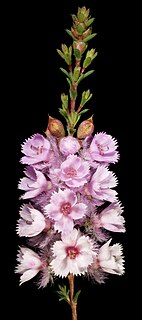
Verticordia pennigera, commonly known as native tea, is a flowering plant in the myrtle family, Myrtaceae and is endemic to the south-west of Western Australia. It is usually a small erect or prostrate shrub with small leaves and lightly-scented spikes of pale pink to magenta-coloured flowers in spring.
Enumeratio plantarum quas in Novae Hollandiæ ora austro-occidentali ad fluvium Cygnorum et in sinu Regis Georgii collegit Carolus Liber Baro de Hügel is a description of the plants collected at the Swan River colony and King George Sound in Western Australia. The author, Stephan Endlicher, used a collection arranged by Charles von Hügel to compile the first flora for the new settlements. Hugel visited the region during 1833–1834, several years after the founding of the colony. The work provided formal descriptions, in Latin, of new species and genera of plants. The single installment was produced in Europe by Endlicher in 1837, the work also included contributions by Eduard Fenzl, George Bentham, Heinrich Wilhelm Schott.
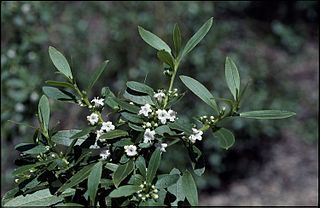
Myoporum caprarioides, commonly known as slender myoporum, is a plant in the figwort family, Scrophulariaceae. It is a shrub with wart-like tubercles covering its branches and leaves, especially on the upper surface and white flowers spotted with mauve, or all blue-mauve, present for most of the warmer months.

Acacia huegelii is a shrub belonging to the genus Acacia and the subgenus Phyllodineae native to Western Australia.
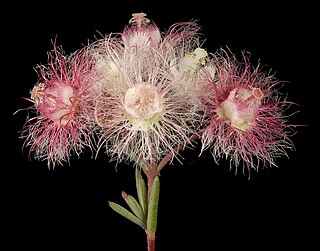
Verticordia huegelii var. huegelii, commonly known as variegated featherflower, is a flowering plant in the myrtle family, Myrtaceae and is endemic to the south-west of Western Australia. It is an upright, slender or bushy shrub, with creamish-white flowers turning pink or reddish maroon as they age, giving the plant a variegated appearance. It is similar to Verticordia huegelii var. decumbens but is more upright than that variety and lacks a lignotuber.

Verticordia huegelii var. decumbens, commonly known as variegated featherflower, is a flowering plant in the myrtle family, Myrtaceae and is endemic to the south-west of Western Australia. It is an almost prostrate shrub, with creamish-lemon coloured flowers turning pink then red as they age, giving the plant a variegated appearance. It is similar to Verticordia huegelii var. huegelii but has a lignotuber and a lower growth habit.
Verticordia huegelii var. tridens, commonly known as variegated featherflower, is a flowering plant in the myrtle family, Myrtaceae and is endemic to the south-west of Western Australia. It is a slender, open, sometimes straggly shrub with bright yellow flowers which age to red and then brown and differently-shaped staminodes from the other varieties of the species.
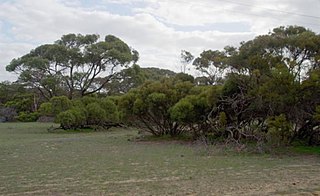
Eucalyptus decipiens, commonly known as redheart or redheart moit is a species of mallee or small tree that is endemic to Western Australia. It has varying amounts of rough, imperfectly shed ribbons of brownish bark and smooth whitish to grey bark, lance-shaped adult leaves, flower buds in groups of between eleven and twenty one, and conical to flattened hemispherical fruit.
Hovea pungens, commonly known as devil's pins, is a shrub in the family Fabaceae, native to Western Australia. The Noongar name for the plant is buyenak.
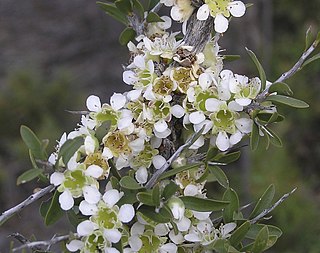
Leptospermum spinescens, commonly known as the spiny tea tree, is a species of spiny shrub that is endemic to Western Australia. It has thick, egg-shaped to elliptical leaves on a short petiole, white or greenish cream flowers, and fruit that remain in the plant for years after reaching maturity.

Boronia lanuginosa is a plant in the citrus family Rutaceae and is endemic to northern Australia. It is a shrub with woolly pinnate leaves.

Bossiaea eriocarpa, or the common brown pea, is a species of flowering plant in the pea family, Fabaceae. It is native to Western Australia, and found in Beard's south-west province.

Macarthuria australis is an erect or spreading, wiry shrub, in the family Macarthuriaceae endemic to Western Australia. It grows from 0.15-0.75 m high and has white/white-cream flowers, and may be seen in flower from May to February although mainly from August to September. It grows on sand and laterite, on coastal sandplains, sandhills, and roadsides.

Boronia falcifolia, commonly known as the wallum boronia, is a plant in the citrus family, Rutaceae and is endemic to near-coastal areas of eastern Australia. It is a shrub with only a few stems, usually three-part leaves and bright pink, four-petalled flowers.
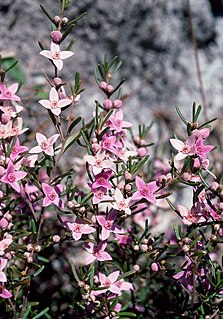
Boronia rosmarinifolia, commonly known as the forest rose, is a plant in the citrus family Rutaceae and is endemic to eastern Australia. It is a shrub with many branches, simple leaves and pale to bright pink flowers arranged singly in leaf axils.
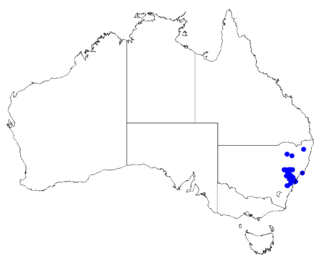
Boronia rubiginosa is a plant in the citrus family Rutaceae and is endemic to New South Wales in Australia. It is a shrub with pinnate leaves that are paler on the lower surface, and up to three pale to bright pink, four-petalled flowers in the leaf axils.


















